Public art comprises art objects and artwork that are sited outside and exposed to the environment in the public domain. Outdoor sculptures form an integral cultural part of any community. Sculptures and statues are sometimes erected in commemoration of a particular event or for an important figure in time past (Figure 1). They also serve as an important landmark for the community in which they stand (Figure 2). In other cases an outdoor artwork is erected as a way of enhancing the surroundings in which artwork is located, such as in sculpture parks.
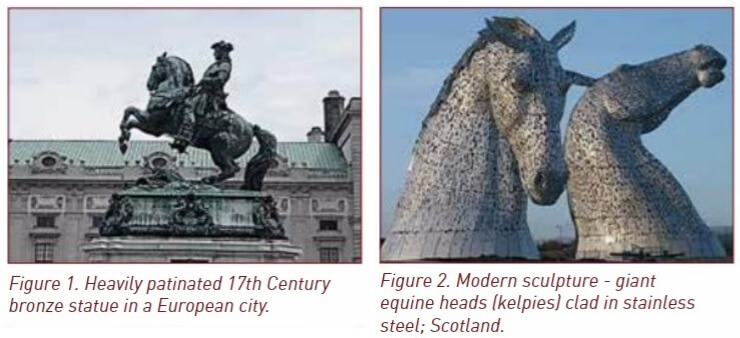
Although the patina formed on an outdoor sculpture is often an aesthetic effect desired by the artist and the owner, the most common problem from an engineering and aesthetic perspective encountered on metal sculptures is unintended corrosion. Conservation and restoration is an important activity dedicated to the preservation, protection and maintenance of art objects. The conservation and maintenance of an outdoor sculpture may be tailored to the needs of a particular piece of artwork at a specific location. Preservation methods employed on an outdoor sculpture must take into account factors such as the artist’s intentions, the existing condition of the artwork, and the immediate environment in which the object is located.
Repair and maintenance works on outdoor sculptures often include surface cleaning, physical repairs and removal of corrosion products, followed by an application of an anti-corrosive surface treatment or sacrificial protective coating. The maintenance and restoration of outdoor sculptures in the public domain is often undertaken or overseen by a professional conservator rather than being included in a generic program of asset management. A standard remediation procedure that gives good results on a sculpture in one location may not be appropriate for a similar art object at another location.
Restoration and Conservation Methods Used in the Past on Outdoor Artwork
In time past one of the main ways to remove corrosion from metal art objects was by chemical means. Sculptures may have been spot treated, or the sculpture may have been completely submerged in a chemical bath. The chemical treatments usually resulted in the removal of any patina and surface deposits, thereby returning the bronze to its original condition. However, the chemical method often produced severe results, such as attacking the metal surface and leaving the object with an unpleasant appearance. The chemical treatment method for metal sculptures is still employed to this day with controlled variations that are not as aggressive as used in the past.
Another approach to the conservation of metal sculptures in the past (often bronze) was to simply not treat the art object all. As expected, this approach had widely varying results. Some metal-base sculptures survived in acceptable condition while others became degraded and fragile over time. Many outdoor sculptures are prized for their original patinas, such as ancient Chinese bronzes, thus in some instances conservators may purposefully not carry out treatments on specific public artwork.
Another method employed in the past, that is not very different from treatments that are still in use today, was to dry the artwork, carefully remove any visible corrosion manually or mechanically, and seal or coat the surface of the metal object with wax or lacquer. Other corrosion removal methods employed in the past included application of a variety of substances on the object’s surface, ranging from secret concoctions to materials as mundane as a proprietary oven cleaner or lemon juice.
The restoration methods used on outdoor sculptures in past centuries had strengths and weaknesses. However, the well-founded intention of sculptors, restorers and conservators in the past was to ensure that art objects survived the ravages of time and exposure in the outdoor environment in order to be available for the enjoyment of future generations. (For more on this subject, see Protecting Outdoor Bronze Sculptures from Corrosion.)
Contemporary Methods for Restoration and Conservation of Outdoor Artwork
Assessment of the artwork condition. Nowadays, conservation of outdoor art objects has a robust scientific basis. Before any conservative action can be taken on an outdoor sculpture a condition assessment of the art object is carried out. The assessment process includes, but is not limited to, reviewing past conservation condition and conservation reports, preparing a current photographic survey, assessing the structural integrity, undertaking scientific analysis, and, if possible, holding discussions with the artist, fabricator and asset owner as to the implementation of desired outcomes of any conservation treatment. It may also be the case that a trial of an appropriate conservation treatment will be carried out prior to any restoration being undertaken on the art object.
There are generally five steps that come with the condition assessment of an outdoor metal sculpture. The five steps involved are as follows:
- Technical description of the art object. The description includes identification of the materials, information on the construction methodology, assessment of past maintenance practices, determination of the present surface condition, characterization of the deterioration and corrosion products, and description of the structural integrity. Also of value are descriptions of the effects of maintenance treatments and repairs undertaken in the past.
- Determination of the causes of degradation or corrosion. This involves an evaluation of the effects of the surrounding environment of the artwork where it is staged.
- Maintenance recommendations for the sculpture. The recommendations are based on the history, condition, location of the sculpture, the cause of deterioration, resources of the owner, and the relative needs of the sculpture in the context of an entire public art asset collection.
- Assignment of treatment priorities. The conservator can assign priorities based on technical information that has been gathered. The priorities are assessed in relation to the risks to the art object in the short, medium, and long term, the risks to public health and safety, the funds available, and other relevant site-specific issues.
- Estimate of the resources required. The labor costs of the proposed maintenance options are expressed in monetary terms or in hours of work required for conservators, technicians, and other specialists, for example, a corrosion consultant. Supplies required and the equipment costs for the restoration are included at this stage.
The conservation project for the outdoor sculpture then moves to the next stage where the methodology for conservation or restoration and repair of the art object is determined, planned, and carried out.
Cleaning and Removal of Corrosion Products and Surface Deposits
The removal of encrustations, adherent deposits and corrosion products off the surface is an important first step in the remediation of an art object after the initial condition assessment is completed. There are many techniques that are available to carry this process out and a number of the standard conservation procedures are outlined below:
Hand cleaning. The basic method for removing corrosion products and deposits off an outdoor sculpture is by manual cleaning. The cleaning method can include heating to soften old wax and applying a solvent at a specific location to dissolve and remove the wax or old coatings. This is followed by removal of surface debris with a plastic spatula and dental tools.
Water blasting. Another mechanical method for cleaning an outdoor sculpture is by pressure water blasting. The water can be pressurized to varying levels depending on the pressure needed for an individual case. Different nozzle types on a water blaster can direct the flow of water in various ways, which provides versatile cleaning of the surface of the art object. (Read Understanding the Industry Shift To Wet Abrasive Blasting for more ideas on this method.)
Abrasion by surface peening. Peening is used in the conservation profession for the cleaning of metal objects that need to be precisely prepared. Peening with glass beads leaves no residue and produces a relatively clean surface. Unwanted scales, accretions or corrosion products are knocked off the metal surface by the force of the blasting.
A metal sculpture surface can also be peened on a microscopic scale. However, some conservators oppose the use of glass bead peening for reasons such as it can remove metal from the surface thereby decreasing the corrosion resistance of the artwork. Alternative peening methods that are less abrasive than glass bead peening include abrasion with crushed walnut shells and the use of dry ice blasting [1].
The application of a coating material onto the surface of an outdoor sculpture is a common conservation method. (Related reading: Using Modern Coatings to Restore Historical New York Landmarks.) Coatings are selected for their durability, adhesion, ease of maintenance and surface appearance. Considerable research has gone into identifying and testing the best coating materials for protecting outdoor sculptures [2]. The selection of an appropriate coating system for a sculpture is governed by factors such as the existing metal surface, environmental considerations, and the degree of maintenance that is expected.
Gloves and cloths. For outdoor sculptures nitrile or similar gloves are utilized. Soft cotton cloths are commonly used to buff wax coatings on metal sculptures once they have cooled and hardened.
Detergents. Neutral or non-ionic detergent solutions are used for the preliminary washing of an object to help remove surface deposits. Detergents increase the wetting action of water thereby increasing its ability to remove grime and other undesirable matter adhering to the surfaces of an outdoor sculpture.
Waxes. There are many types of natural and proprietary waxes that have been evaluated and used in conservation work for protecting outdoor art objects [3, 4, 5]. Carnauba wax or beeswax suspended in a solvent (e.g., turpentine) perform well on metal patinas and they are fast drying. However, if waxes are applied onto a warm metal surface they may smear or cause deposits to build up.
Brushes. Soft bristle brushes are often used for the application of liquefied wax onto the surface of a sculpture. Paintbrushes may be employed for the initial cleaning of a metal object with tape wrapped around the metal ferrule of the brush so that the ferrule does not make direct contact with the sculpture surface causing scratching.
Lacquers and corrosion inhibitors. Proprietary lacquers have been evaluated and employed as protective coatings for metal sculptures over many years [6]. A proprietary product called Incralac is a clear acrylic lacquer that has often been used for outdoor copper alloy sculpture conservation [7]. Incralac is made of a synthetic resin with the addition of a corrosion inhibitor (benzotriazole, BTA). Incralac is a durable lacquer for outdoor exposure conditions and it also has a UV stabilizing property which is beneficial for the longevity of the lacquer on metal art objects.
Whatever method of conservation or restoration is chosen for an outdoor sculpture, the methodology, remediation procedure and outcome of restoration, must be properly documented. The record should include collation of the condition assessment, results of testing or trials, and a detailed description of the remedial work that was carried out. The latter should include photo documentation and a list of the materials and equipment utilized. Comprehensive documentation of a treatment is the best means to ensure that future conservation work can be carried out with all available knowledge of the past history of the artwork.
Case Studies of Corrosion Issues on Outdoor Sculptures
In the following section a number of case studies of corrosion issues relating to outdoor sculptures made of different materials are outlined. The selected cases illustrate short term and long term problems encountered when outdoor sculptures have been affected by atmospheric corrosion. (Learn more in The 5 Factors of Atmospheric Corrosion.) Each case illustrates degradation of the sculpture material due to its location in a specific environment. In three of the cases the artwork was able to be reinstated by carrying out an appropriate restoration procedure. In the fourth case it was considered important by the artist and sculpture owners to carry out preliminary research to identify the most appropriate remediation treatment available before restoration of a prominent public artwork proceeded.
Restoration of a 100-Year-Old Bronze Statue
A bronze statue of Queen Victoria (Francis Williamson sculptor) was commissioned for her Diamond Jubilee. The bronze statue was installed in Albert Park, central Auckland city in 1889. The Queen Victoria sculpture, mounted on a large granite pedestal, was unveiled before a large public gathering at Albert Park in that year. After more than 100 years of exposure in the marine environment that prevails in Auckland city, the bronze statue exhibited extensive and disfiguring corrosion. In response, in 2006 Auckland City commissioned a conservation and restoration project to be undertaken on the well-known bronze statue.
A description follows of the Queen Victoria bronze statue condition, after an assessment had been carried out by conservators [8]. The sculpture showed severe corrosion of the bronze partially due to intricate detail and raised texture of the cast bronze surface. The bronze surface was covered with streaks, run-offs and disfiguring corrosion layers. Corrosion testing on the bronze confirmed the presence of localized chloride corrosion products, particularly atacamite [Cu2(OH)3Cl]. The corrosion on the cast bronze was not uniform; there were heterogeneities present on the metal surfaces such as pores and boundaries between areas enriched with metallic inclusions (tin and zinc).
The imperfections on the bronze surfaces had become preferential sites for corrosion processes, e.g., pitting corrosion. From the exterior, it appeared that pitting and perforations had developed on the bronze particularly around the neck of the figure. Some years prior, the head of the figure had to be re-welded to the body along the neckline following an act of vandalism that decapitated the statue. If fragments of the iron casting armature or ferrous metal pins or bolts were still present in the interior of the cast bronze, there was the possibility of galvanic corrosion occurring. The granite pedestal and plinth on which the statue was displayed were in good condition, with some losses of the gold leaf inscription.
The conservators decided that the specification for the treatment and remediation of the bronze Queen Victoria statue (an intervention) should be as follows:
1. Remedial conservation treatment. Once the statue had been removed to an indoor location (Figures 3 and 4) all of the bronze surfaces were closely inspected. It was necessary to assess the extent of remedial treatment and repairs required to address the disfiguring corrosion as well as any material losses and structural damage. Fortunately, inspection revealed that reconstruction of parts of the statue was not necessary other than minor brazing repairs around the neck area (Figure 5).
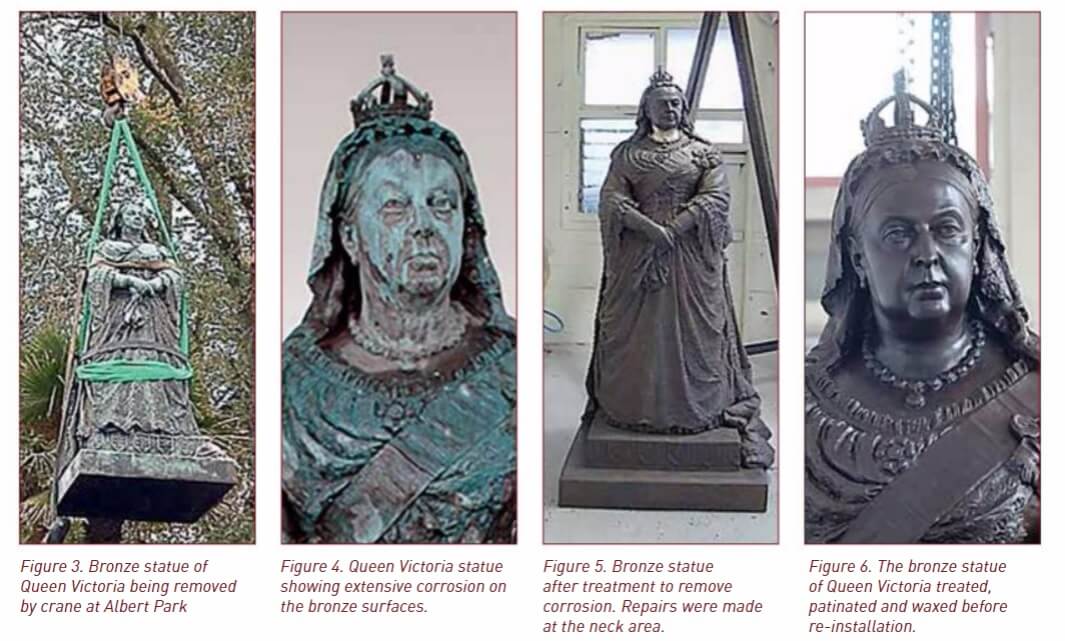
Conservation commenced with cleaning of the bronze surface to remove deposits and loose corrosion products. The initial treatment was followed by controlled mechanical and chemical removal of adherent corrosion products. The tools employed included abrasive pads, scalpels, peening with glass micro-beads, high pressure water washing, and chemical treatment using chelating agents and an acid. The objective during the remediation process was to achieve a cohesive surface layer of cuprite (Cu2O) whilst preserving as much of the stable bronze patina as possible.
2. Repatination of the bronze. Final repatination of the bronze statue was based on documentation, aesthetic and functional aspects, in consultation with the conservators and public art and heritage personnel at Auckland Council.
3. Application of a protective coating. The final surface finish decided upon was hot application of microcrystalline wax comprising paraffin waxes. The temperature of the wax coating during application was kept in the range of 80°C to 100°C (176°F to 212°F). Finally, a maintenance specification for the protective wax coating, particularly the ideal renewal time interval, was decided.
The conservation project on the Queen Victoria statue was very successful. The bronze statue is in very good condition to this day, in part due to the implementation of a regular maintenance program. As specified by the conservators, the bronze statue receives an annual re-application of a protective wax coating to maintain the desired patination on the bronze.
Corrosion Issues on a Modern Wind Sculpture
Kinetic art is a modern form of artwork made from any medium that contains movement perceivable by the viewer, or upon motion, for its effect. A wind sculpture installed next to a harbor comprised ten colored poles, each with a pivoting cone reminiscent of windsocks. The cones spin, light up at night and make sound. The wind sculpture comprise ten painted galvanized steel poles six meters high, with the pole bases embedded in the ground or on the seashore (Figure 7).
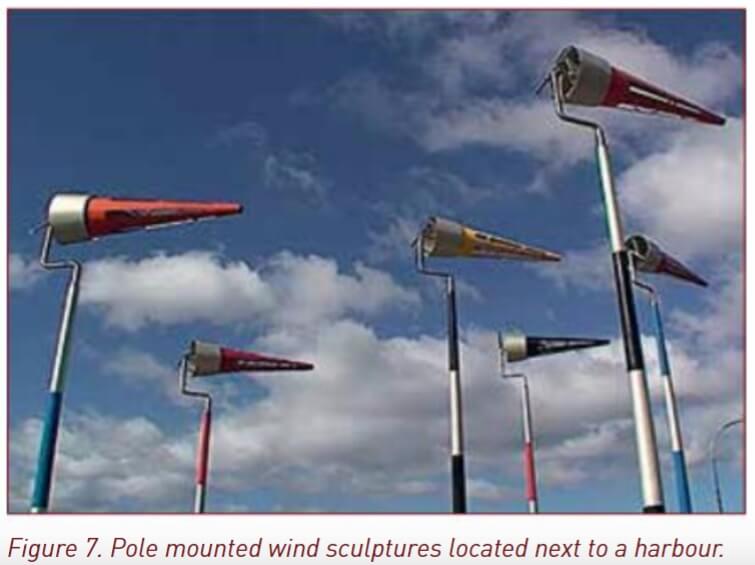
Not long after installation cracking occurred in a weld on the grade 316L stainless steel support arm for the pivoting windsock on one of the kinetic sculptures. The sculptures were subjected to wind velocities of 100 km/hour (62 mph) or higher and vibrate vigorously in the wind. The stainless steel pipe cracked at a weld adjacent to a pipe elbow on the U-shaped support arm. The weld at the other end of the elbow on the support arm also showed cracking (Figure 8).
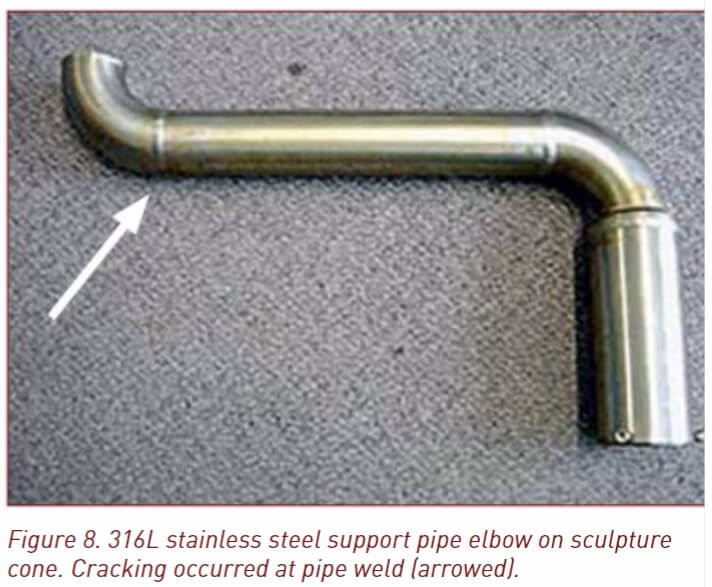
The kinetic sculptures were also exposed to a severe marine environment as well as high wind loadings. Chlorides from windborne sea salt (i.e., marine aerosol) gained access inside the support arm pipe during service. The pipe weld showed some lack of penetration across the throat of the weld and there was heat tint present on the stainless steel around the internal root of the weld. (For more on this topic, see Corrosion Fatigue of Welded Joints On Marine Offshore Structures.) Heat tinting on stainless steel welds is undesirable as it encourages corrosion to occur on welds exposed to a corrosive environment. The cracking in the pipe weld was found to be due to a mechanism called chloride stress corrosion cracking (SCC). Residual tensile stresses from fit-up and welding had contributed to the SCC.
Indications of fatigue were also observed on the stainless steel weld fracture face at high magnification in a scanning electron microscope (SEM). The cracking was likely assisted by fatigue due to cyclical loading on the sculpture support arm in wind. The cracking initiated at a notch at the root of the pipe weld where there was incomplete weld penetration. The notch and the presence of chlorides inside the stainless steel pipe arm supported an environmental cracking mechanism.
Designers generally know that grade 316L stainless steel is susceptible to stress corrosion cracking. Exposure of 316L stainless steel in a marine environment has to be managed through good design to ensure that cracking does not occur on vibrating parts. The lesson learned from this case was that when employing structural stainless steel components for modern outdoor sculptures an important feature prior to construction is to embrace good design including a welding procedure specification.
Corrosion Problem on a Lake Sculpture
Large outdoor sculptures are sometimes staged in a sculpture park with artwork on display over many hectares of land. In an outdoor art collection, corrosion occurred on the metal base of a hollow stainless steel sculpture that floated in a freshwater lake. The floating stainless steel sculpture was anchored to the lake bed (Figure 9). Corrosion of metal fixing components occurred adjacent to lifting lugs that formed part of the base of the floating artwork structure with its base submerged in the lake water.
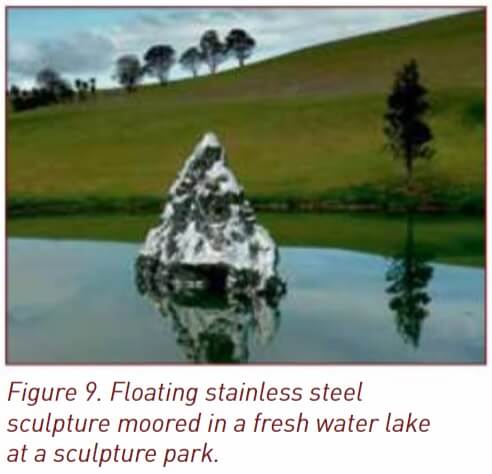
The floating sculpture was fabricated from an unknown grade of stainless steel. There had been historic corrosion issues on the chain that secured the floating artwork to the heavy cast steel mooring on the lake bed. The steel mooring chain had been replaced with stainless steel chain and a magnesium anode attached to the chain to halt the galvanic corrosion occurring. However, the connections of the chain to the submerged base of the sculpture continued to corrode.
A sample of corrosion product from the submerged base component was submitted to X-ray analysis (energy dispersive X-ray spectroscopy, EDS) in a scanning electron microscope, to identify the alloy employed for the connection. The analysis results indicated that the stainless steel component had undergone corrosion in the lake water. The grade of ferritic stainless steel employed for the base connection showed inadequate corrosion resistance submerged in the lake water. Free-machining grades of stainless steel have low corrosion resistance when exposed in a corrosive environment.
A higher grade stainless steel was required for the sculpture base component. The stainless steel employed for the sculpture base components and the mooring chain needed to be the same grade of stainless steel to avoid galvanic corrosion, that is, dissimilar metal corrosion between carbon steel and stainless steel. The use of an anode to provide cathodic protection (CP) to the steel mooring chain was unnecessary if the sculpture mooring connection components were all made from the same stainless steel alloy. Selection of grade 316L stainless steel was an appropriate choice for the component to attach the floating stainless steel sculpture base to the heavy cast steel mooring on the lake bed.
The lesson learned from this case was that appropriate grade selection of a stainless steel is most important to avoid problems when constructing a stainless steel outdoor sculpture. Selecting the correct grade of stainless steel for an outdoor environment is a key part of good stainless steel design.
Corrosion Issues on a Bronze Sculpture Located in a Public Domain
An outdoor artwork in a sculpture park at a public domain in Auckland was fabricated using cast silicon bronze and the sculpture comprised a set of modular bronze castings joined together. When installed in the sculpture park around 2005 the bronze had an attractive matt finish honey-gold color. The artist wished to maintain the natural honey-gold color of the polished bronze sculpture indefinitely without using any form of patination process.
Figure 10 shows the honey-gold color on a cast test piece of the silicon bronze. For various reasons, the polished surface of the bronze sculpture had not been cleaned and coated with wax annually, as part of a maintenance plan. Wax is applied onto the bronze surfaces to stop the metal from coming into contact with an aggressive marine aerosol that prevails over the Auckland isthmus.

In 2010, the first clean and attempt to restore the honey-gold color of the bronze sculpture took place. The restoration work was completed with a two-coat waxing of the bronze surfaces. Prior to 2010 the bronze sculpture had developed a streaky surface appearance with what appeared to be ‘rust spots’ on areas of the bronze surface (Figure 11). Cleaning of the sculpture had taken place in winter and the cleanings were impacted by the weather which delayed the conservation process; as a result the waxing was not carried out immediately after the sculpture cleaning.
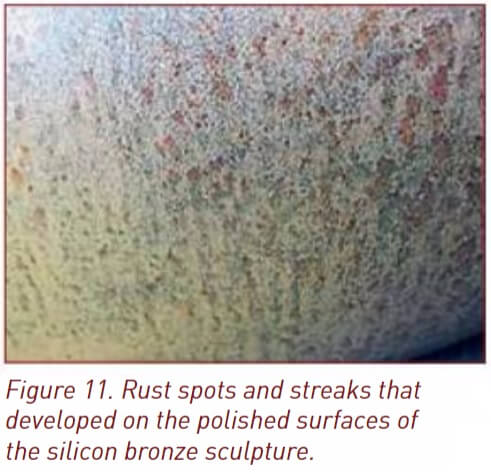
Examination of the red-brown spots and streaks on the polished bronze surfaces confirmed that the deterioration of the bronze surface was likely due to contamination by minute particles of iron embedded in the bronze surface during the casting process. Alternatively, the surface contamination occurred when the castings were cleaned by shot blasting at the foundry. The embedded iron particles had undergone galvanic corrosion in contact with the bronze on the sculpture surface. Iron oxide (red rust) was produced and the corrosion products weeped under gravity from spots on the bronze surface producing streaks that were aesthetically unpleasant.
It was important for the artist and Auckland Council Public Art to carry out some research to identify the most appropriate restoration method available before conservation work commenced. Fortunately, an unexposed sample of the original silicon bronze cast material, as a disc (Figure 10), was available for testing and research. The research program carried out on the bronze disc included (a) chemical analysis, (b) metallurgical examination of the bronze microstructure, (c) environmental exposure testing of the sample in a severe marine environment with different protective coatings applied onto the polished bronze surface.
The composition of the bronze (X-ray fluorescence (XRF) analysis) was found to be only slightly out of specification for alloy UNS C87600 (silicon bronze). The silicon bronze showed a slightly elevated level of iron (Fe) present. Metallurgical analysis also indicated that the surface of the silicon bronze casting contained a slightly elevated iron level; otherwise the cast silicon bronze microstructure was normal.
The surface of the bronze disc was polished and prepared for exposure testing. The bronze surface was polished by manual abrasion with ultra-fine silicon carbide pads. The surface finish achieved was better than on the actual bronze sculpture, as only light surface oxidation had to be removed from the bronze alloy. The polished surface of the bronze disc was cleaned and degreased. The polished disc was then masked off into four segments (quadrants). Each quadrant was treated with one of four different coating systems that were often used by conservators for bronze sculpture restoration in order to minimize atmospheric corrosion of the sculpture substrate.
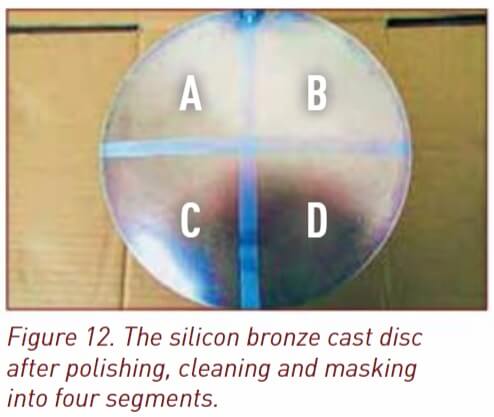
The four segments on the bronze sample are shown in Figure 12. The identification marks, A, B, C and D, were chosen to identify each of the four coating systems that were subsequently applied. The quadrants on the bronze disc were treated as follows:
A: Application of 5% w/v benzotriazole (BTA; copper corrosion inhibitor) in ethanol followed by a hot microcrystalline wax application. Two further coats of wax were cold-applied.
B: Application of Incralac acrylic coating followed by two cold-applied coats of microcrystalline wax.
C: Cold application of Fishoilene corrosion prevention compound.
D: Hot application of microcrystalline wax with BTA incorporated into the wax. A second coat of wax was cold-applied.
The bronze disc was exposed in a vertical orientation to the prevailing marine environment, attached to the cabin of an old dredge moored by a wharf at the National Maritime Museum in Auckland. The dredge was situated on the edge of Auckland harbor (Figure 13). The bronze disc was installed facing northeast and the sample was rain washed during the exposure period. The exposure time in the marine environment on the dredge was approximately three months. The bronze disc was removed and swabs of visible corrosion products were taken off each quadrant. The swab samples were subjected to microscopic examination and to X-ray analysis (EDS) of the corrosion products in a scanning electron microscope.
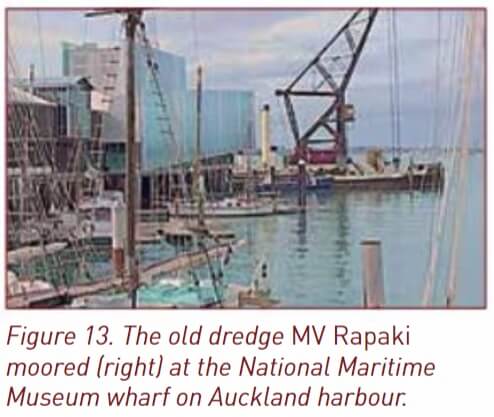
After examination, the segment of the bronze disc that performed best with least surface corrosion on the polished bronze surface was Sample B, the Incralac coating with two additional coats of wax. The second best surface treatment, with slight corrosion occurring on the bronze surface, was Sample C, Fishoilene. The remaining two treatments had the highest surface corrosion on the polished bronze, and corrosion performance results about the same, namely Samples A and D coated with microcrystalline wax plus BTA.
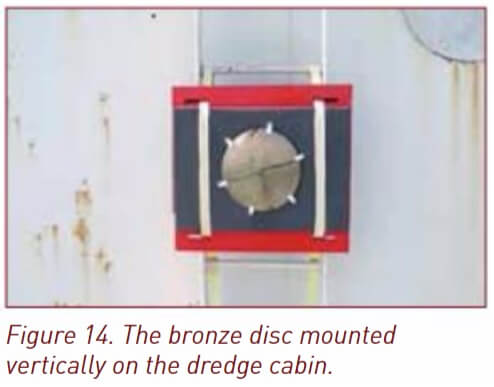
The results of the short-term exposure testing of the four coatings on the bronze sample on the dredge demonstrated that the Incralac plus wax protective coating was superior to the other three coating systems tested. The results were somewhat surprising, because application of wax plus BTA has been recommended by conservators for protection of outdoor bronze sculptures for many years.
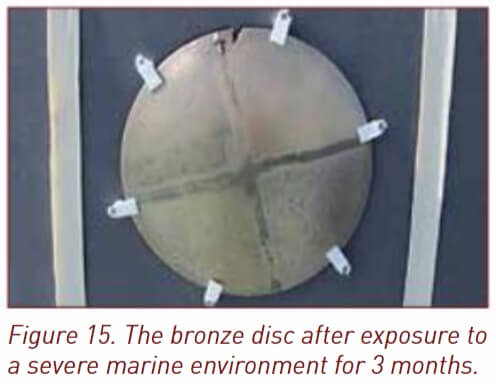
After the research was completed the Public Art managers were advised of the following recommended process for restoration of the honey-gold color on the silicon bronze sculpture. Correct logistics were noted to be critical to the success of the bronze sculpture refurbishment.
Initially the bronze sculpture should be cleaned and mildly blasted (walnut shell) to remove any surface residues and corrosion products. After blasting the sculpture should be cleaned immediately with non-ionic detergent solution and rinsed with clean water to remove the detergent residues. Following water rinsing the sculpture surfaces should be cleaned with a solvent (e.g., white spirits) to remove the last traces of any surface residues off the bronze surfaces.
A full even coat of Incralac should be sprayed onto the cleaned sculpture surfaces. The applicator should follow the recommendations of the manufacturer for the application and drying time of the Incralac coating. Once the Incralac coating has fully cured, apply two coats of microcrystalline wax. The first wax coating should be lightly buffed with soft cotton pads before the second wax coating is applied. The second wax coating should be gently buffed after application.
The application of a new wax coating should be undertaken annually as a protective coating on Incralac. The waxing is necessary to ensure that the prevailing marine atmosphere does not cause deterioration of the acrylic coating on the bronze. During maintenance and re-waxing of the sculpture it is important to insure that the wax coating on the sculpture is not cleaned with a solvent. Solvents can have a deleterious effect on an Incralac coating. The wax-coated bronze sculpture surface should be periodically washed with clean water to remove any surface contaminants.
The exposure testing and research on the silicon bronze sample that was carried out provided the sculpture park managers with a basis for restoring and protecting the polished silicon bronze sculpture against atmospheric corrosion in the prevailing marine environment.
Conclusions
Corrosion issues arise on outdoor public art from time to time which require investigation and remedial actions to be taken as advised by conservation specialists. Conservators are professionally trained to carry out conservation and restoration processes on public art using established scientifically based remediation methodologies.
The occurrence of a failure on an outdoor art object due to an unexpected engineering problem requires an immediate response and appropriate remediation work to be implemented.
Conservation, restoration and maintenance of outdoor public art make an important contribution to a community.
References
[1] Van der Molen R., Joosten I., Beentjes T. and Megens L., Dry ice blasting for the conservation cleaning of metals, Proceedings of METAL 2010, James and James (Science Publishers) Ltd., USA, 2010, pp 135-141.
[2] Brostoff L.B. and E. Rene de la Rie, Research into protective coating systems for outdoor bronze sculpture and ornamentation, Proceedings of METAL 95, James and James (Science Publishers) Ltd., USA, 1997, pp 242-244.
[3] Otieno-Alego V., Hallam D., Viduka A., Heath G. and Creagh D., Electrochemical impedance studies of the corrosion resistance of wax coatings on artificially patinated bronze, Proceedings of METAL 98, James and James (Science Publishers) Ltd., USA, 1998, pp 315-319.
[4] Otieno-Alego V., Heath G., Hallam D. and Creagh D., Electrochemical evaluation of the anti-corrosion performance of wax coatings for outdoor bronze conservation, Proceedings of METAL 98, James and James (Science Publishers) Ltd., USA, 1998, pp 309-314.
[5] Wolfram, J., Brueggerhoff, S. and Eggert, G., Better than Paraloid B72 – Testing POLIGEN Waxes as a Coatings for Metals, Proceedings of METAL 2010, James and James (Science Publishers) Ltd., USA, pp 167-173.
[6] Conservation and preservation of outdoor bronze objects; Wikipedia.com
[7] Letardi P., Laboratory and field tests on patinas and protective coating systems for outdoor bronze monuments, Proceedings of METAL 2004, National Museum of Australia, Canberra, Australia, 2004, pp 379-386.
[8] Yuda E., Conservation of bronze statue of Queen Victoria, Auckland City Artwork Asset No.RIQ09, Albert Park, Auckland, Artifacts Conservation Ltd, May 2006.
This article was provided from the Australasian Corrosion Association from their publication Corrosion & Materials.